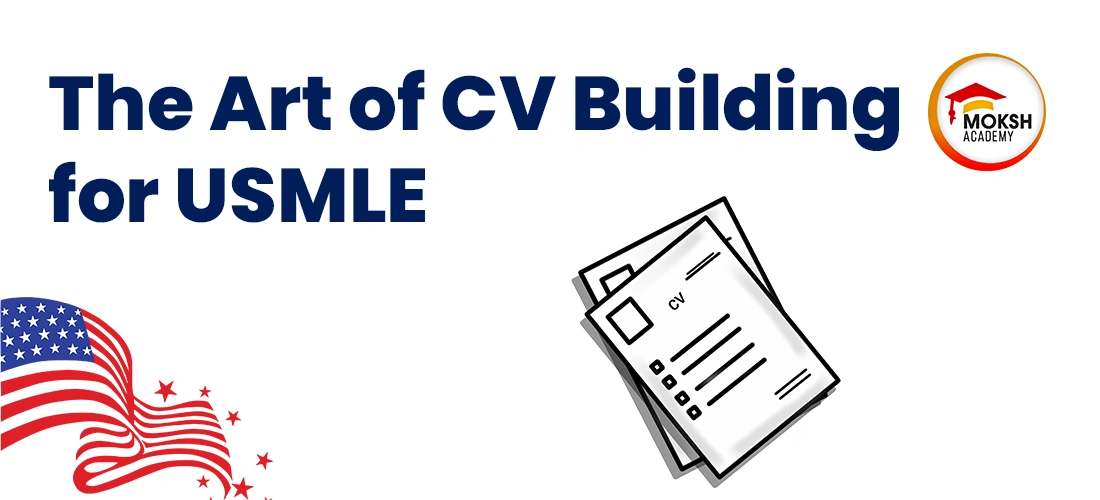
Understanding the Importance of a CV for USMLE
Are you worried about how to build a CV for USMLE? A well-crafted CV is an essential component of your USMLE application. It serves as a snapshot of your qualifications, achievements, and experiences, allowing residency program directors to assess your suitability as a candidate. A strong CV can greatly enhance your chances of securing a coveted residency position. It is crucial to understand the significance of a CV in the USMLE process and invest time and effort in building a compelling one.
Your CV provides a comprehensive overview of your professional and academic background, highlighting your strengths and accomplishments. It allows program directors to evaluate your capabilities in a concise and structured manner. A well-organized CV can help you stand out from the competition and create a positive impression.
Components of an ERAS CV
The Electronic Residency Application Service (ERAS) CV is the standard format for USMLE applications. It consists of several key sections, each serving a specific purpose. Understanding these components and their significance is essential to understand how to build a CV for USMLE -
- Personal Information - Include your name, contact information, and relevant personal details such as nationality and visa status.
- Education - List your educational qualifications, starting from the most recent. Include the name of the institution, degree obtained, dates of enrollment, and any honors or awards received.
- Clinical Experience - Detail your clinical rotations, internships, and relevant work experience. Specify the institution, specialty, dates, and responsibilities undertaken.
- Research Experience - Highlight any research projects you have been involved in, including publications, presentations, or conferences attended.
- Publications and Presentations - Provide a list of your published work, including journal articles, book chapters, and conference presentations.
- Honors and Awards - Mention any academic or professional achievements, scholarships, or honors received.
- Extracurricular Activities - Include any leadership roles, community service, or volunteer work that demonstrates your commitment and well-roundedness.
- Skills - Enumerate any specific skills or certifications relevant to your desired specialty.
Structure of an ERAS CV Format
You need to know the ERAS CV Format. The formatting and structure of your ERAS CV are crucial for readability and impact. Follow these guidelines to ensure your CV is well-organized and visually appealing:
- Use a clear and professional font, such as Arial or Times New Roman, with a font size between 10 and 12 points.
- Maintain consistent formatting throughout the document, including headings, bullet points, and indentation.
- Use concise and specific language to describe your experiences and achievements.
- Keep your CV to a maximum of two pages, excluding references.
- Proofread your CV thoroughly to eliminate any grammatical or spelling errors.
- Use section headers and subheadings to delineate different sections of your CV.
- Include your name and page number as a header or footer on each page.
- Save your CV as a PDF to preserve formatting and ensure compatibility across devices.
By adhering to these formatting and structure guidelines, you can present your information clearly and professionally, make a good ERAS CV format, and maximize the impact of your CV.
Tips for Writing a Standout ERAS CV
Writing a standout ERAS CV requires careful thought and attention to detail. Consider the following tips to make your CV stand out from the competition:
- Tailor your CV to the specific specialty or program you are applying to. Highlight experiences and skills that are relevant to your desired field.
- Quantify your achievements whenever possible. Include numbers, percentages, or specific outcomes to demonstrate the impact of your work.
- Use action verbs to describe your responsibilities and accomplishments. This adds dynamism and engages the reader.
- Prioritize recent experiences and achievements, especially those directly related to your desired specialty.
- Pay attention to the order and flow of information. Present your most important and relevant experiences first.
- Be honest and accurate in your representation of skills and experiences. Avoid exaggeration or misrepresentation.
- Seek feedback from mentors, advisors, or trusted colleagues. They can provide valuable insights and help you refine your CV.
- Continuously update your CV as you gain new experiences or achievements. Keep it dynamic and reflective of your growth. Do check on the sample ERAS CV.
By implementing these tips, you can create a standout ERAS CV that effectively communicates your qualifications and sets you apart from other applicants.
Using an ERAS CV Template
An ERAS CV template can serve as a helpful starting point for building your CV. These templates provide a standardized format and structure, ensuring that you include all the necessary information. However, it is crucial to personalize the template and tailor it to your specific experiences and accomplishments.
When using an ERAS CV template, follow these guidelines:
- Choose a template that is clean, professional, and visually appealing.
- Customize the template to include your details, experiences, and achievements.
- Ensure that the template is compatible with the ERAS system and can be saved as a PDF.
- Use the template as a guide but avoid being overly reliant on it. Add your unique touch to make your CV stand out.
Remember, the template is just a starting point. It is essential to personalize and tailor your CV to effectively showcase your qualifications and experiences.
Successful ERAS CV Example
Looking at a successful ERAS CV example can provide valuable insights and inspiration for building your own. Here are a few key features to observe in exemplary CVs:
- Clear and concise organization: Successful CVs have a logical flow of information, with clear section headings and subheadings.
- Relevant and impactful experiences: Highlight experiences that directly relate to your desired specialty, emphasizing achievements and outcomes.
- Quantifiable achievements: Use numbers, percentages, or specific outcomes to demonstrate the impact of your work.
- Strong language and action verbs: Engage the reader with dynamic language and action verbs that convey your responsibilities and accomplishments.
- Personalized touches: Each successful CV has a unique touch that reflects the candidate's personality and individuality.
By studying successful sample ERAS CVs, you can gain insights into effective strategies and techniques for crafting your standout CV.
Common Mistakes to Avoid in Your ERAS CV
When building your ERAS CV, it is crucial to avoid common mistakes that can undermine the effectiveness of your application. Be mindful of the following pitfalls:
- Excessive length: Keep your CV concise and within the recommended two-page limit, excluding references.
- Irrelevant information: Focus on experiences and achievements that are directly related to your desired specialty. Avoid including irrelevant or outdated information.
- Poor organization: Ensure that your CV is well-structured and easy to navigate. Use clear headings and subheadings to guide the reader.
- Grammatical or spelling errors: Thoroughly proofread your CV to eliminate any errors. Grammatical or spelling mistakes can create a negative impression.
- Lack of specificity: Use specific language to describe your experiences and achievements. Vague or generic statements can weaken your CV.
- Inconsistent formatting: Maintain a consistent formatting style throughout your CV, including headings, bullet points, and indentation.
- Overemphasizing non-clinical experiences: While extracurricular activities can add value to your CV, ensure that clinical experiences take precedence.
By avoiding these common mistakes, you can ensure that your ERAS CV remains strong and impactful, increasing your chances of securing a residency position.
How to Tailor Your CV for USMLE Applications
Tailoring your CV for USMLE applications is crucial to effectively showcase your qualifications and experiences. Consider the following steps to tailor your CV:
- Research the desired specialty or program: Understand the specific requirements and expectations of the specialty or program you are applying to. Do Refer ERAS CV sample.
- Identify relevant experiences and achievements: Highlight experiences, skills, and achievements that directly align with the specialty or program.
- Customize your CV accordingly: Prioritize and emphasize the most relevant experiences, ensuring they are prominent in your CV.
- Use specific language and keywords: Incorporate specialty-specific terminology and keywords to demonstrate your familiarity and expertise.
- Seek feedback from mentors or advisors: Share your tailored CV with trusted individuals who can provide valuable insights and suggestions. Also, you can find an ERAS CV example or we can say ERAS resume sample.
By tailoring your CV to the specific USMLE journey, you can effectively communicate your qualifications and increase your chances of success.
Resources for CV Preparation for USMLE
Preparing a strong CV for USMLE applications can be a daunting task. Fortunately, several resources can assist you in this process. Consider the following:
- USMLE official website: The USMLE website provides valuable guidance and resources for CV preparation, including sample CVs and formatting guidelines.
- MOKSH LMS: The MOKSH Academy learning management system provides one of the best CV-building guidance. It covers all important criteria and steps to prepare a strong CV. It will provide an ERAS CV Example as well.
- Residency program websites: Many residency programs offer guidance and tips for CV preparation on their websites. Utilize these resources to align your CV with their expectations.
- Online forums and communities: Platforms such as Reddit have dedicated communities discussing CV preparation for USMLE. Engage with these communities to seek advice and learn from others' experiences.
- Mentors and advisors: Reach out to mentors or advisors who have experience in the USMLE process. They can provide personalized guidance and feedback on your CV.
- Professional CV writing services: Consider utilizing professional CV writing services specializing in medical residency applications. These services can offer expert insights and help you create an impactful CV.
By utilizing these resources, you can enhance your CV preparation process and increase your chances of securing a residency position.
Conclusion
Mastering the art of CV building for USMLE Preparation is a crucial step in securing a residency position. A well-crafted CV for ERAS can effectively communicate your qualifications, achievements, and experiences to residency program directors. By understanding the importance of a CV, familiarizing yourself with the components and formatting of a sample ERAS CV, and implementing tips for writing a standout CV, you can create a compelling application.
Remember to personalize your CV, tailor it to the specific USMLE application, and avoid common mistakes that can weaken your CV. Utilize resources such as templates, ERAS CV examples, ERAS CV samples, and online communities to enhance your CV preparation process with the guidance of MOKSH Academy. With a strong CV in hand, you are well-positioned to embark on your journey towards a successful USMLE application. Good luck!



